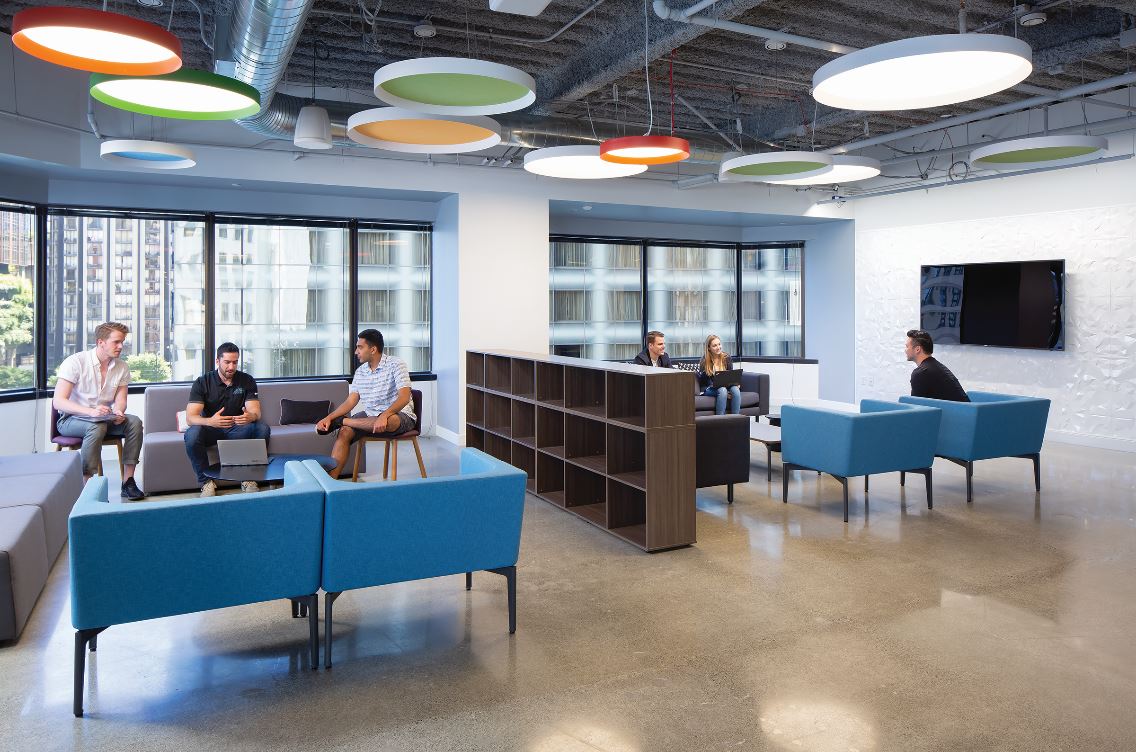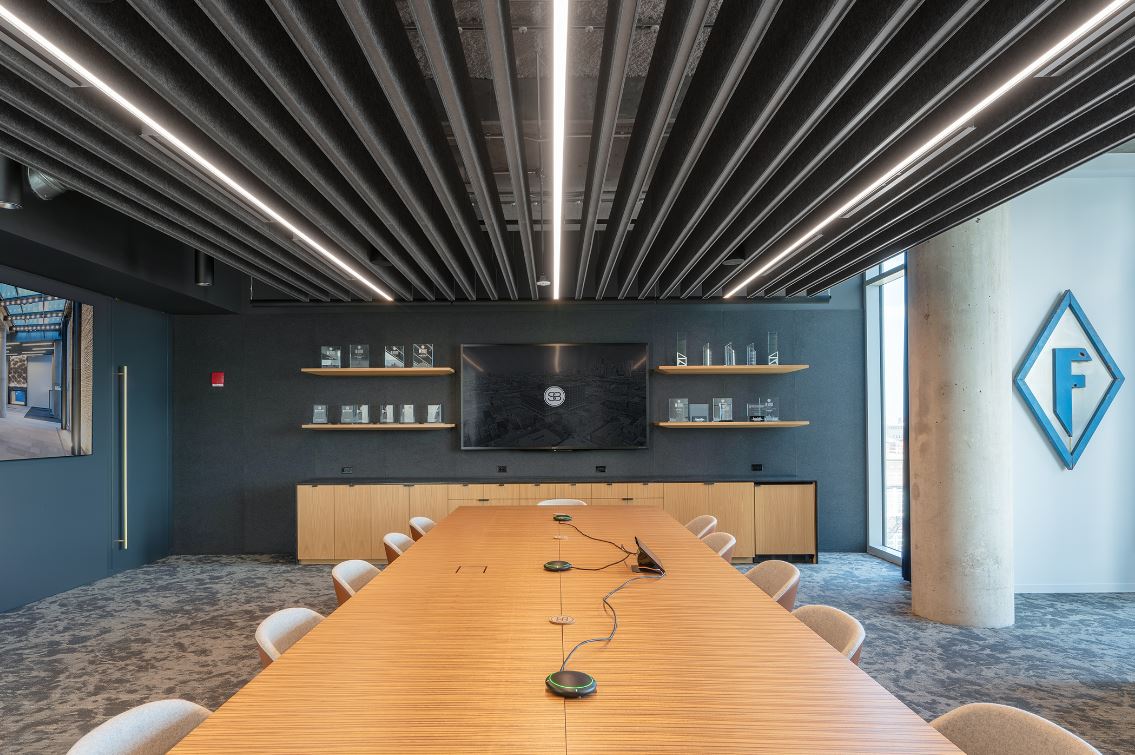Focal Point, LLC. shares the latest innovations and considerations in designing human-centric environments, adding value for companies and comfort for employees.

A demographic shift in the workforce continues to take place with the penetration of Generation Z. This tech-savvy and highly engaged generation has different expectations than the previous generations for their work environments. As a result, companies are seeking new ways to appeal to Gen Z while also maximizing productivity. A widespread strategy for attracting and retaining these potential employees has emerged by designing work environments that include the latest amenities such as collaboration areas, flexible workstations, biophilic design, and connected building technology.
With these evolving workplaces come wide-open spaces outfitted with sleek, low-profile desks, conference rooms framed by glass walls, and a proliferation of hard surfaces such as concrete floors and ceilings. While appealing from a visual standpoint, these spaces create new challenges related to confidentiality and acoustic comfort.
In recent years, this has led to a dramatic increase in the demand for acoustical solutions. It is vital that employers look beyond furnishings and high-tech elements to design acoustically-optimized spaces that focus on the comfort of those that inhabit them. Addressing acoustic comfort can ultimately contribute to the success of a company while also meeting applicable building standards.
Recent research suggests that workers lose about ninety minutes per day due to distractions, with half of all workers reporting an inability to concentrate while in the office. Given that office workers spend two-thirds of their time doing quiet work, it is evident that acoustic comfort should be a consideration when designing commercial office spaces.
According to the World Green Building Council as stated in their Health, Wellbeing and Productivity in Offices report, it is estimated that over 90 percent of an organization’s operating costs are linked to employee efficiency. When efficiency and productivity decrease, operating costs increase significantly.
As the trend toward creating more human-centric environments continues to grow, designers should be aware of the latest innovative solutions available and the applicable building standards that support acoustic optimization. Today’s interior products are addressing more than sound management, reducing echoing and reverberation issues while enhancing other aspects of interiors, such as lighting and aesthetics.

Addressing noise without compromising design
Historically, acoustical ceiling tiles (ACTs) or wall panels were commonly used to address acoustic comfort and minimize reverberation issues, often at the expense of aesthetics. In recent years, furniture manufacturers recognized the increase in noise and lack of confidentiality issues caused by the disappearance of cubicles and private offices, resulting in the introduction of commercialized phone booths and sitting nooks made of sound absorbing material. While supportive of employee privacy, these products fail to improve the overall acoustic comfort of a space.
Acoustics are becoming a prerequisite for open ceiling environments, and an influx of innovative sound absorbing products are beginning to penetrate the market. These acoustic ceiling solutions can add complexity during the specification and installation process, including the need for extra coordination to incorporate other building components such as sprinklers, speakers, and lighting.
Recognizing the challenges associated with the multi-use needs of a ceiling plane, leading architectural lighting manufacturers have introduced integrated acoustical ceiling and lighting systems. These sound absorbing solutions offer many advantages: they address noise and reverberation issues and deliver a cohesive aesthetic while also meeting the lighting requirements of a space.
Furthermore, integrated acoustic and lighting systems simplify the sourcing and installation process with one manufacturer supplying a unified system. The flexible systems are currently available in various form factors, with the most prevalent being linear baffles and cloud systems.
Where to begin
When selecting a solution, it is critical that designers first consider the goals of the space beyond sound management and take into account variables such as design aesthetics, budget, and the incorporation of other building components. For example, if the goal is to hide an open ceiling structure, ACTs or a dense array of an integrated acoustical ceiling and lighting system may be suitable.
If the goal is to maintain a view of the open ceiling structure or to reduce the budget, an integrated acoustical lighting system can be optimized – varying the height, spacing, orientation, and product type – while still meeting the acoustic targets and required light levels. Beyond understanding the available solutions and how to use them, designers should be aware of organizations and standards that are bringing awareness to the importance of addressing human health and well-being by supporting acoustic optimization.

Standards supporting human comfort
Global building certifications such as the WELL Building Standard™ and the Leadership in Energy and Environmental Design (LEED) are driving change to balance health and wellness in commercial building design by promoting the creation of more human-centric environments. Both WELL and LEED offer guidance on managing acoustics for various occupied environments.
WELL provides arguments that support acoustic abatement strategies that reinforce occupant health and well-being. WELL is a premier standard for buildings, interior spaces, and communities seeking to implement, validate, and measure features that support and advance human health and wellness. The program, designed by the International WELL Building Institute™ (IWBI™), is based on scientific and medical research and articles on behavioral and health factors that suggest a correlation between productivity and health benefits as they relate to building design, construction, and management.
The growing importance of acoustic comfort is evidenced through the evolution of WELL certification requirements. In WELL v2, sound management is segmented out into a specific Sound Concept, a progression from WELL v1 where sound management was included in the Comfort Concept. The Sound Concept identifies five Features that shape an occupant’s experience and aim to bolster occupant health and well-being.
Feature S04, part of the Sound Concept, specifically focuses on the requirements for sound absorption. Part 1 provides thresholds for reverberation times and makes recommendations based on room functionality and size. Part 2 relates to applying sound reducing ceiling solutions, specifically addressing the amount of sound absorbed onto a surface and ceiling coverage area, measured by a Noise Reduction Coefficient (NRC).
WELL focuses on the connection between building and occupant health and wellness while LEED, a standard for the design, construction, and operation of high-performance buildings, targets maximizing occupant health and productivity by using fewer resources and reducing waste.
LEED v4 includes prerequisites and credits related to acoustics under the Building Design and Construction (BD+C) and Interior Design and Construction (ID+C) rating systems. The LEED BD+C prerequisites apply to schools and address HVAC background noise, exterior sounds, and reverberation time.
The LEED BD+C and LEED ID+C Acoustic Performance Credit addresses HVAC background noise, sound transmission, reverberation time, sound reinforcement and masking systems. It also outlines specific requirements related to speech privacy, sound isolation, and background noises for healthcare environments. Integrated acoustical lighting systems contribute to lowering RT in interior spaces, helping meet the requirements of both WELL and LEED that pertain to sound absorption.
Now more than ever, sound level is an important consideration when designing any space, especially open, multi-functional interior environments. As employers seek new ways to attract and retain a new generation of talent and increase employee productivity, now is the time to consider delivering a more acoustically comfortable environment.
Manufacturers are recognizing the need for products that contribute to healthier and more sustainable environments, providing innovative sound absorbing solutions. The importance of creating more human-centric environments has been elevated by new and evolving building standards.



Very informative, relevant information for co- working space